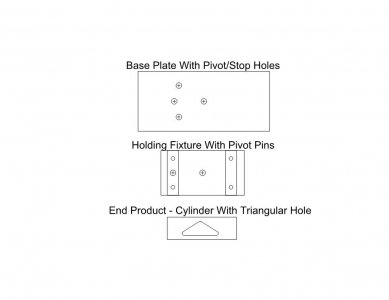I'm new to milling and am starting a fixture project. The fixture will be made of 2 plates, which will rotate on a pin and have 2 stop holes at 35 degrees off center of the flat plate.
With a DRO can one achieve enough accuracy to drill/ream the holes on each of the plates, or would one figure out a way to drill/ream each hole through both pieces at once.
Since a picture's worth a thousand words, there's an attachment of the fixture I'm planning.
Thanks & Best Regards,
Jon

With a DRO can one achieve enough accuracy to drill/ream the holes on each of the plates, or would one figure out a way to drill/ream each hole through both pieces at once.
Since a picture's worth a thousand words, there's an attachment of the fixture I'm planning.
Thanks & Best Regards,
Jon


